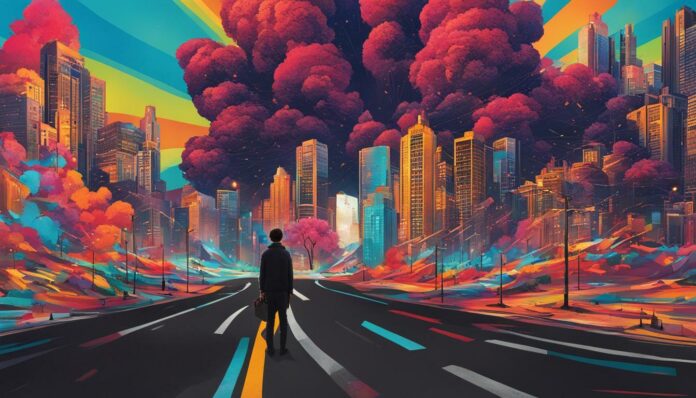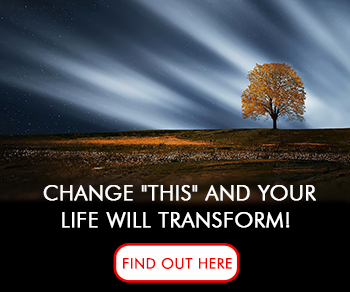Why is creativity important in todays world when it seems we are so focused on machines?
In a rapidly evolving world, creativity plays a pivotal role in personal growth, career success, and the advancement of society. It goes beyond artistic expression and encompasses a wide range of benefits that impact various aspects of our lives.
From problem-solving and innovation to self-expression and intercultural connections, creativity has the power to transform individuals and communities.
Key Takeaways: Why is Creativity Important
- Creativity engages the mind and keeps it active.
- It nurtures a sense of togetherness and teamwork.
- Creative thinking challenges us to find alternative solutions.
- It connects reflection with action, leading to innovative outcomes.
- Creativity builds bridges between cultures and fosters intercultural connections.
Unleashing Personal Growth through Creativity
Creativity is the key that unlocks personal growth, empowering individuals to tackle challenges, foster innovation, and enhance their creative abilities. It is a powerful force that allows us to think outside the box, explore alternative solutions, and push the boundaries of what is possible. It is almost a spiritual awakening to learn (or maybe relearn) to use our creative side. By embracing creativity, we can embark on a journey of self-discovery and self-expression, opening ourselves up to new ideas, perspectives, and opportunities.
One of the most significant benefits of creativity is its ability to enhance problem-solving skills. When we approach challenges with a creative mindset, we are better equipped to discover innovative solutions that may not have been evident through conventional thinking. Creativity encourages us to think critically, analyze situations from different angles, and explore uncharted territories. It fosters a willingness to take risks and experiment with new approaches, ultimately leading to breakthroughs and personal growth.
To foster creativity and enhance our creative skills, it is essential to create an environment that nurtures and supports our imaginative endeavors. This can involve engaging in creative activities such as painting, writing, or playing an instrument. It can also involve seeking inspiration from others, exploring new hobbies, or joining creative communities where ideas can be shared and cultivated. By immersing ourselves in these experiences, we can develop our creative muscles, expand our horizons, and unleash our full creative potential.

| Benefits of Creativity | Enhancing Creative Skills |
|---|---|
|
|
“Creativity is intelligence having fun.” – Albert Einstein
Unlocking Your Creative Potential
To truly harness the power of creativity, it is important to cultivate a mindset that embraces and celebrates the creative process. This involves letting go of self-judgment and fear of failure, as these can inhibit our ability to fully explore and express our creativity. By adopting a growth mindset and viewing failures as learning opportunities, we can unlock our true creative potential.
Embrace curiosity and engage in activities that inspire you. Whether it’s immersing yourself in nature, exploring different cultures, or simply allowing your imagination to run wild, these experiences can fuel your creativity and ignite your passion for self-expression. Surround yourself with like-minded individuals who support and encourage your creative endeavors. Collaboration and diverse perspectives can enhance your creative thinking and help you generate unique ideas and solutions.
In conclusion, creativity is not just a skill, but a way of life. By embracing our innate creativity, we can unlock personal growth, foster innovation, and enhance our creative abilities. So, let your imagination soar, embrace the unknown, and unleash the power of creativity for a life filled with purpose and meaning.
Remember, in the words of Pablo Picasso, “Every child is an artist. The problem is how to remain an artist once we grow up.”
Nurturing Creativity in Education
Education is the foundation where creativity takes root, nurturing young minds and equipping them with the skills needed for innovation and success. In today’s rapidly changing world, fostering creativity in educational settings is crucial to prepare students for the future. By integrating creativity into the curriculum, educators create an environment that encourages critical thinking, problem-solving, and overall learning outcomes.
One of the key ways to nurture creativity in education is by embracing a multidisciplinary approach. By exposing students to various subjects and disciplines, they are encouraged to explore different perspectives and think outside the box. This approach not only enhances their creativity but also helps them develop the ability to connect seemingly unrelated concepts, leading to innovative thinking.
| Ways to Nurture Creativity in Education |
|---|
| Embrace a multidisciplinary approach |
| Encourage curiosity and exploration |
| Provide opportunities for self-expression |
| Foster collaboration and teamwork |
Curiosity and exploration are also essential in nurturing creativity. Encouraging students to ask questions, seek answers, and explore their interests helps them develop a sense of wonder and curiosity about the world. This curiosity fuels their imagination and allows for the discovery of new ideas and solutions.
Furthermore, providing opportunities for self-expression is crucial in nurturing creativity. By allowing students to express their thoughts, emotions, and ideas through art, writing, or other creative outlets, they develop a sense of confidence and authenticity. It gives them a voice and empowers them to share their unique perspectives with the world.
In addition, fostering collaboration and teamwork in the classroom nurtures creativity. By working together on projects and solving problems as a team, students learn to value diverse perspectives and leverage collective thinking for innovative solutions. Collaboration also enhances communication and interpersonal skills, which are essential for success in the modern world.
The Role of Creativity in Education
According to Sir Ken Robinson, an expert on creativity in education, “Creativity is as important in education as literacy, and we should treat it with the same status.” Creativity is not just a skill; it is an essential mindset that enables students to thrive in an ever-changing world. By nurturing creativity in education, we empower students to become lifelong learners, critical thinkers, and problem solvers.
“Creativity is as important in education as literacy, and we should treat it with the same status.” – Sir Ken Robinson
As Albert Einstein once said, “Imagination is more important than knowledge.” Creativity is the gateway to imagination, and education plays a vital role in unlocking and channeling this creative power within each student. By providing an environment that fosters creativity, we equip students with the tools they need to navigate the challenges and opportunities of the future.
Education is not just about acquiring knowledge; it is about nurturing the whole person. By embracing creativity in education, we cultivate individuals who are not afraid to think differently, challenge the status quo, and create positive change in the world. It is through creativity that we inspire the next generation of innovators, problem solvers, and leaders.
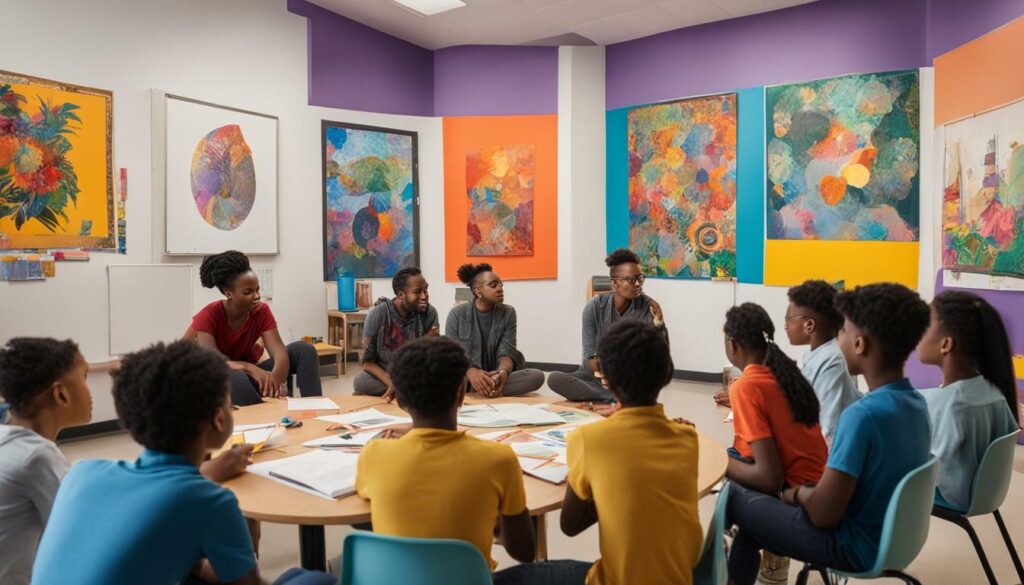
Being able to embrace creativity in education is a powerful gift. It opens doors, ignites passions, and propels individuals on a lifelong journey of discovery and growth. In today’s rapidly evolving world, nurturing creativity in education is more important than ever. By valuing and fostering creativity, we empower students to dream big, think boldly, and become architects of their own success.
Fueling Creativity in the Workplace
The workplace is an arena where creativity thrives, fueling innovation, inspiring collaboration, and propelling businesses forward. In today’s fast-paced and ever-evolving world, organizations that embrace and promote creativity gain a competitive edge over those that stifle it. The benefits of fostering a creative environment in the workplace are numerous, from increased productivity and problem-solving capabilities to enhanced employee engagement and satisfaction.
When creativity is encouraged, employees feel empowered to think outside the box, challenge the status quo, and explore new possibilities. This mindset fosters a culture of innovation, where fresh ideas are welcomed, and risks are seen as opportunities for growth. As a result, organizations become more adaptable and resilient in the face of change, positioning themselves for long-term success.
| Benefits of Fostering Creativity in the Workplace: |
|---|
| 1. Increased productivity and efficiency. |
| 2. Enhanced problem-solving and critical thinking skills. |
| 3. Improved employee engagement and satisfaction. |
| 4. Innovation and competitive advantage. |
| 5. Adaptability and resilience in the face of change. |
| 6. Collaboration and teamwork. |
| 7. Employee development and talent retention. |
“Creativity is the fuel that drives businesses forward. By fostering a creative environment, organizations tap into the limitless potential of their employees, unlocking new levels of innovation, collaboration, and growth.” -Unknown
Embracing creativity requires a shift in mindset and a commitment to creating a supportive culture. It involves providing employees with the time, resources, and autonomy to explore their ideas, experiment, and take calculated risks. Leaders play a crucial role in setting the tone and leading by example, championing creativity and celebrating the successes that arise from it.
By promoting innovation and creativity in the workplace, organizations stand to gain a workforce that is more engaged, motivated, and fulfilled. They cultivate an environment where ideas flourish, problems are solved with ingenuity, and individuals are empowered to reach their full potential. Fueling creativity in the workplace is not just a choice, it is a necessity for businesses that strive to thrive in the dynamic and ever-evolving landscape of today.
Workplace Creativity Key Takeaways
- Creativity in the workplace fuels innovation, collaboration, and business success.
- Fostering a creative environment leads to increased productivity, engagement, and adaptability.
- Leaders play a crucial role in promoting and nurturing creativity within their organizations.
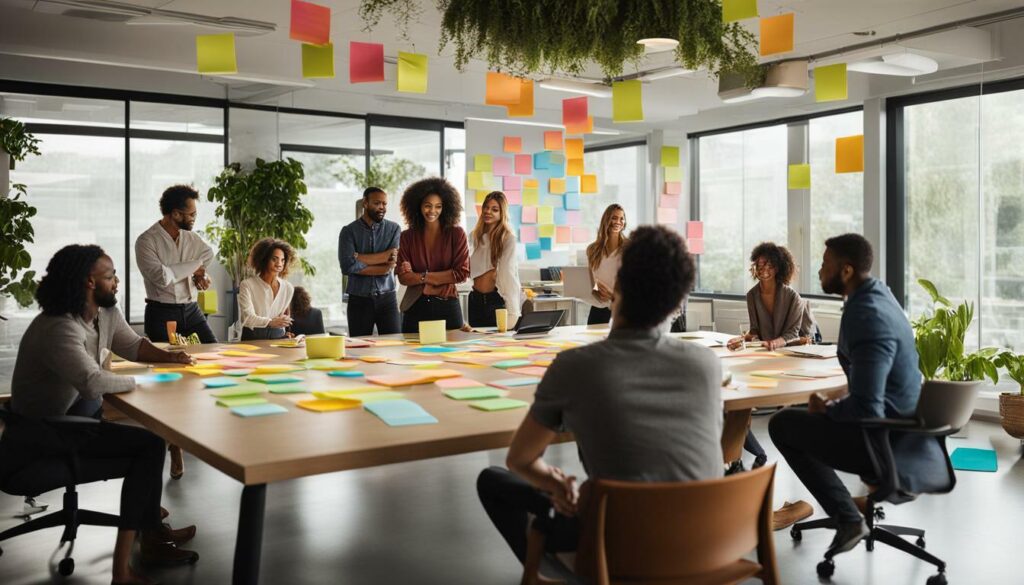
Connecting Creativity and Self-Expression
Creativity is the language through which we express our innermost thoughts, empowering us to find our voice, gain confidence, and share our unique perspectives with the world. It is a powerful tool that nurtures self-expression, allowing us to communicate our thoughts, emotions, and ideas in ways that words alone cannot capture. When we engage in creative activities, we tap into our imagination, unlocking a world of possibilities where we can freely express ourselves.
Through creativity, we can break free from the limitations of conventional thinking and explore uncharted territories. It encourages us to think outside the box, push boundaries, and challenge the status quo. By embracing our creativity, we embark on a journey of self-discovery, where we uncover hidden talents, passions, and strengths that help us shape our identity.
| Benefits of Creativity in Self-Expression: | |
|---|---|
| 1. Nurtures Confidence: | Creativity fosters a sense of self-assurance as we express ourselves authentically, allowing our true selves to shine through. It gives us the courage to share our ideas and perspectives with others, knowing that our voice matters. |
| 2. Gives a Voice: | Creativity provides a platform for individuals of all backgrounds to be heard. It gives us the power to communicate our experiences, beliefs, and emotions, bridging gaps and fostering understanding among diverse communities. |
| 3. Nurtures Curiosity: | Creativity fuels our innate curiosity, inviting us to explore new concepts, ideas, and ways of thinking. It encourages us to ask questions, seek knowledge, and dive deeper into the world around us. |
Whether through art, music, writing, or any other creative outlet, self-expression allows us to connect with ourselves and others on a deeper level. It is a form of storytelling that transcends boundaries, languages, and cultures. When we embrace our creativity, we open ourselves up to new possibilities, experiences, and connections that enrich our lives.
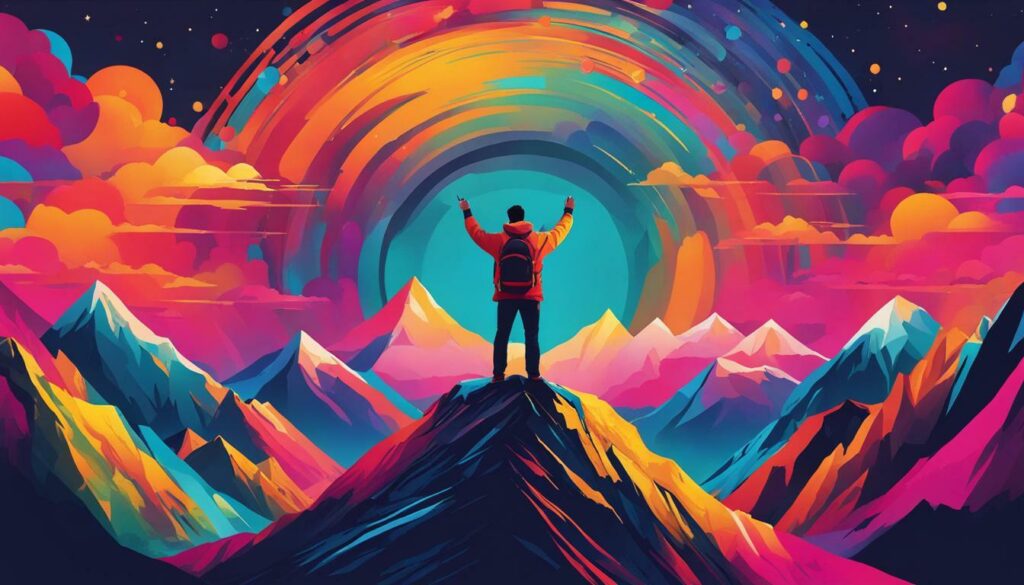
Embracing our creative potential not only allows us to find our voice but also nurtures confidence, instills curiosity, and stimulates our minds. It empowers us to express our authentic selves, share our stories, and contribute to the world around us. So, let your creativity flow, and let it be a vessel for self-expression, growth, and connection.
Inspiring Collective Thinking and Collaboration
Creativity is the force that ignites collective thinking, inspiring individuals to come together, share ideas, and collaborate towards meaningful outcomes. When we tap into our creative potential, it stimulates and motivates us to explore new possibilities and challenge conventional thinking. By connecting reflection with action, creativity encourages us to not only generate ideas but also implement them to drive positive change.
“Creativity requires the courage to let go of certainties.” – Erich Fromm
One of the ways creativity fosters collective thinking is by nurturing a culture of innovation within teams and organizations. When individuals are empowered to think creatively, it opens the door to diverse perspectives and promotes constructive dialogue. By embracing creativity, teams can leverage the unique strengths and expertise of each member, creating a synergy that leads to breakthrough ideas and innovative solutions. This collaborative approach is essential in addressing complex challenges and driving progress in today’s fast-paced world.
Connecting Reflection with Action
It is through the power of creativity that reflection is connected with action. In the process of ideation, discussion, and collaborative problem-solving, individuals are encouraged to think critically and explore multiple angles. By engaging in collective brainstorming sessions and leveraging the creativity of others, new insights emerge, sparking inspiration and driving forward momentum.
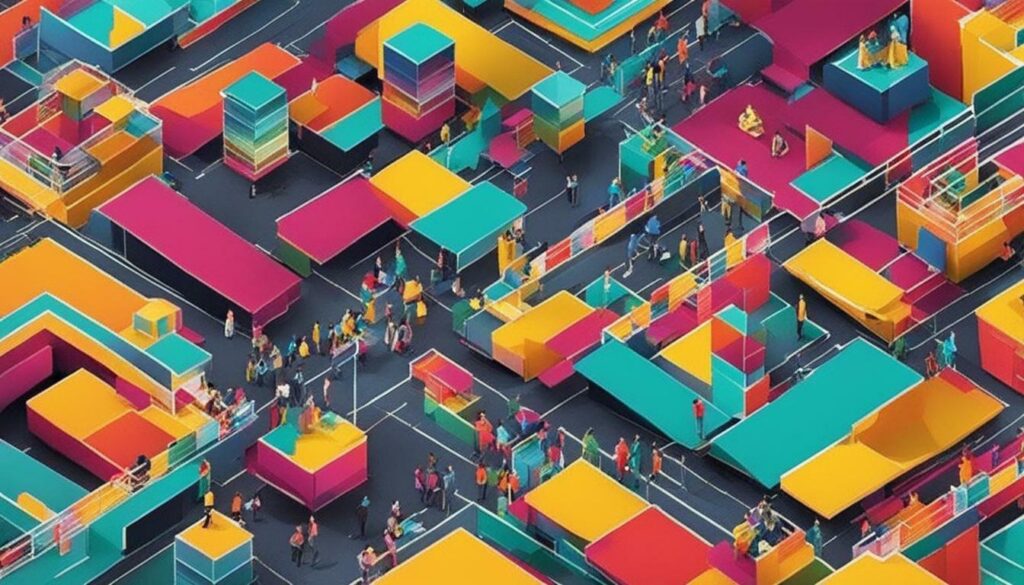
To illustrate the impact of collective thinking, consider the example of a design team working on a new product. Each member brings their unique ideas and expertise to the table, fostering an environment where creativity flourishes. Through open dialogue and collaboration, the team combines their insights, challenges assumptions, and pushes the boundaries of what’s possible. The result is a product that not only meets customer needs but also exceeds expectations, thanks to the power of collective thinking and collaboration.
| Benefits of Inspiring Collective Thinking and Collaboration |
|---|
| Stimulates innovative ideas and solutions |
| Fosters a culture of inclusivity and diversity |
| Encourages open and constructive communication |
| Enhances problem-solving abilities |
| Facilitates knowledge sharing and learning |
By embracing creativity and inspiring collective thinking and collaboration, we unlock the full potential of our teams and organizations. Together, we can create a future filled with innovative solutions, positive change, and meaningful impact.
Embracing Creativity for Intercultural Connections
Creativity knows no boundaries, transcending cultural differences and creating a common language that connects us all. In a world that becomes increasingly interconnected, embracing creativity becomes essential for fostering intercultural connections. It is through creativity that we can bridge gaps, break down barriers, and celebrate diversity.
When we engage in creative endeavors, we tap into a universal human experience that transcends language and cultural norms. Whether it’s through art, music, dance, or storytelling, creativity allows us to express ourselves authentically and connect with others on a deeper level. As we share our unique perspectives and cultural heritage, we gain a deeper understanding and appreciation for one another, fostering empathy and compassion.
To illustrate the power of creativity in building intercultural connections, consider the following example:
“When I attended a cultural exchange program, I was initially hesitant to interact with people from different backgrounds. However, during a creative workshop, we were asked to collaborate on a mural that depicted our shared experiences. Through this process, we learned to communicate without words, relying on our creativity to convey emotions and ideas. As we worked side by side, our differences became a source of inspiration, and we discovered the beauty in our collective creativity. Our mural became a visual representation of unity and harmony, transcending cultural boundaries and leaving a lasting impact on all who viewed it.” – Unknown
Intercultural connections forged through creativity not only lead to personal growth and awareness but also pave the way for a more inclusive and harmonious society. By embracing creativity, we can break down stereotypes, challenge preconceived notions, and foster an environment of mutual respect and appreciation for diverse cultures.
| Benefits of Embracing Creativity for Intercultural Connections |
|---|
| 1. Facilitates understanding and appreciation of diverse cultures |
| 2. Encourages empathy and compassion |
| 3. Breaks down cultural barriers and stereotypes |
| 4. Fosters collaboration and teamwork |
| 5. Promotes cultural exchange and mutual learning |
Embracing creativity for intercultural connections requires an open mind, a willingness to learn, and a genuine appreciation for diversity. By engaging in creative activities together, we can create a harmonious world where cultural differences are celebrated, and unity is fostered through the power of imagination and self-expression.
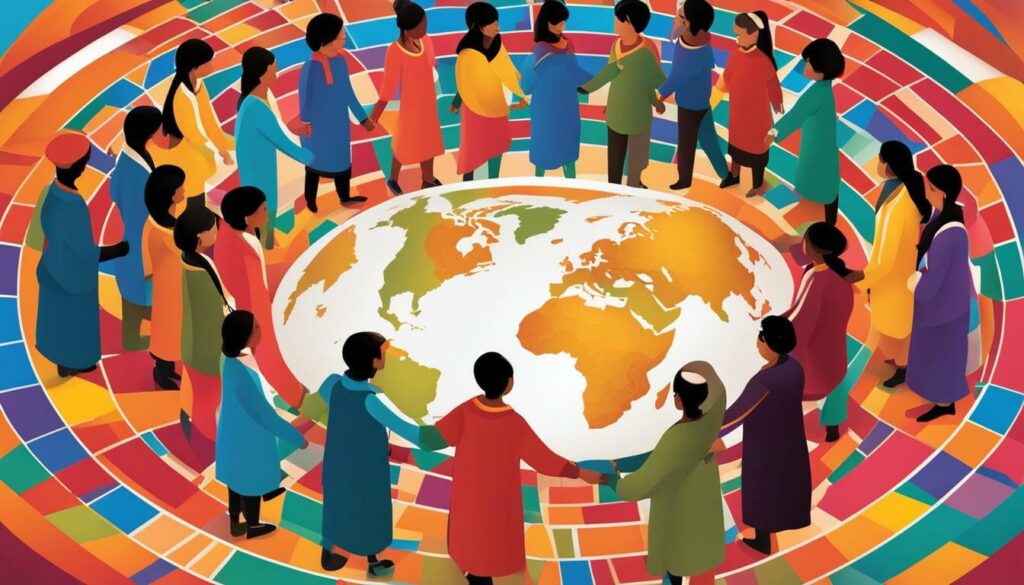
Cultivating Creativity for Resilience and Adaptability
In a world of constant change, creativity becomes the anchor that empowers us to navigate uncertain waters with resilience and adaptability. It supports our ability to embrace new challenges, think outside the box, and find innovative solutions. Creativity fuels our resilience by fostering flexible thinking and encouraging us to explore different perspectives and ideas.
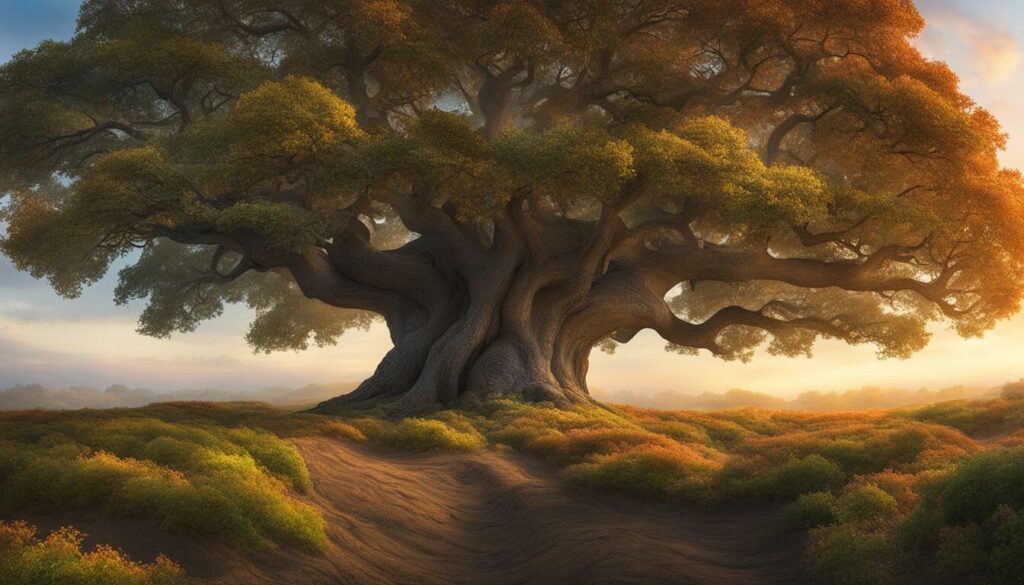
When we cultivate creativity, we equip ourselves with a powerful tool to face the unexpected. It keeps our minds active and engaged, allowing us to approach problems more openly and with innovation. As we learn to think creatively, we become better problem solvers, finding unique ways to overcome obstacles and adapt to changing circumstances.
Moreover, creativity plays a crucial role in our ability to communicate effectively and reduce stress. It opens the door to new forms of expression, enabling us to connect with others on a deeper level. By tapping into our creative selves, we discover new avenues for self-expression and self-discovery.
| Creativity Benefits: |
|---|
| Supports resilience |
| Helps us adapt to change |
| Enhances problem-solving abilities |
| Fosters flexible thinking and innovation |
| Improves communication skills |
| Reduces stress and promotes relaxation |
| Encourages self-expression and self-discovery |
“Creativity is the key to unlocking our limitless potential. It empowers us to adapt, evolve, and thrive in an ever-changing world.”
Therefore, nurturing creativity is essential in today’s rapidly evolving landscape. By embracing our creative power, we can enhance our resilience, problem-solving skills, and ability to adapt to change. It enables us to connect with others, reduce stress, and communicate effectively. Ultimately, creativity holds the key to unlocking our full potential and living a life filled with purpose and meaning.
Unleashing the Power of Creativity for Problem Solving
Creativity breathes life into problem-solving, enabling us to approach obstacles with fresh eyes, innovative ideas, and a sheer determination to find solutions. In a world that is constantly evolving, the ability to think creatively is more important than ever. It empowers us to tackle challenges from different perspectives, opening doors to new possibilities and breakthroughs.
When we tap into our creative potential, we unlock a wellspring of innovative thinking that can revolutionize problem-solving. Creative problem-solving goes beyond conventional approaches and embraces unconventional ideas that may have been overlooked. It encourages us to think outside the box, explore uncharted territories, and challenge the status quo.
One of the primary benefits of using creativity in problem-solving is the ability to solve problems more openly and with innovation. By engaging our creative faculties, we cultivate a mindset that welcomes experimentation and embraces failure as an opportunity for growth. This mindset allows us to generate unique ideas and solutions that traditional problem-solving methods may have missed.
| Benefits of Creativity in Problem Solving: |
|---|
| 1. Encourages out-of-the-box thinking |
| 2. Stimulates innovation and fresh ideas |
| 3. Fosters a growth mindset and resilience |
| 4. Explores alternative approaches and perspectives |
| 5. Enhances collaboration and teamwork |
Embracing creativity in problem-solving not only fuels personal growth but also contributes to collective progress. When individuals come together and combine their creative thinking, the possibilities for solving complex problems become limitless. Collaborative problem-solving draws upon the diverse perspectives and expertise of a group, resulting in more robust solutions and breakthrough innovations.
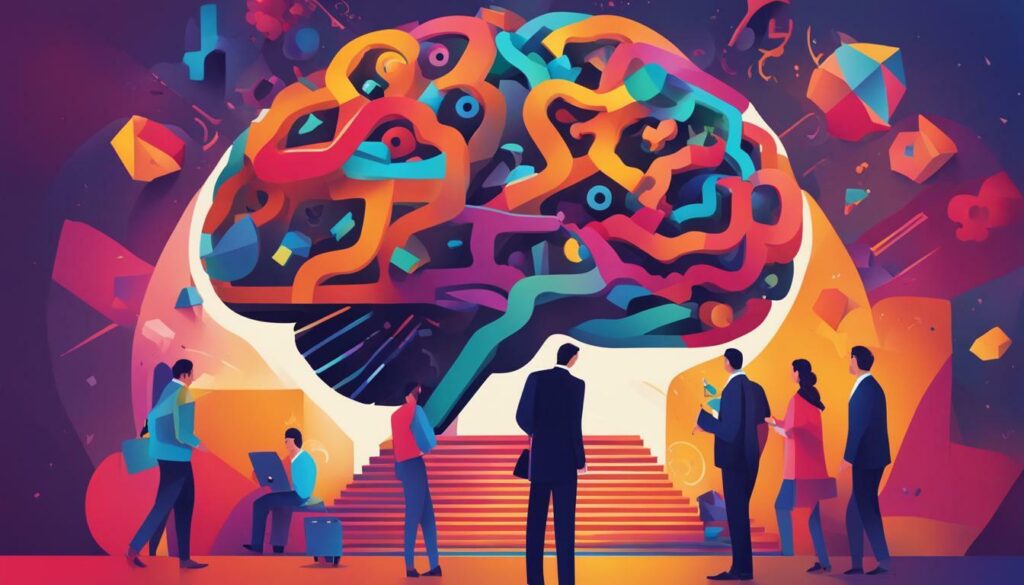
As we navigate the challenges of the modern world, harnessing the power of creativity for problem-solving becomes an essential skill. It enables us to adapt, thrive, and find effective solutions even in the face of uncertainty. So, embrace your creative potential, dare to think differently, and unlock the boundless possibilities that lie within.
Enhancing Communication and Reducing Stress through Creativity
Creativity is the bridge that enhances communication, enabling us to express ourselves more effectively, connect with others on a deeper level, and find solace in moments of stress and relaxation. Through creative expression, whether it be through art, music, writing, or any other form, we can convey our thoughts, emotions, and experiences in a way that words alone cannot capture. It opens up a world of possibilities, allowing us to communicate with clarity and authenticity.
When we engage in creative activities, we tap into a space of self-expression that goes beyond conventional communication. It allows us to delve into the depths of our imagination, exploring new ways to convey ideas and connect with others. Whether it’s through painting, dancing, or writing poetry, creativity allows us to communicate our innermost thoughts and feelings in a way that resonates with others.
Studies have shown the benefits of creativity in enhancing communication skills. Creative expression improves our ability to listen actively, understand different perspectives, and empathize with others. It encourages us to think outside the box, fostering innovative ideas and approaches to problem-solving. By engaging in creative activities, we sharpen our communication skills, enabling us to effectively convey our thoughts and emotions to others and establish deeper connections.
| Key Benefits of Creativity in Communication: |
|---|
| 1. Enhances expression: Creativity provides a platform for individuals to express themselves authentically and uniquely, enabling clearer communication. |
| 2. Improves empathy: By engaging in creative practices, we develop a deeper understanding of others’ experiences, fostering empathy and enhancing our ability to connect. |
| 3. Encourages innovative thinking: Creative activities stimulate our imagination, allowing us to think outside the box and generate new ideas, leading to more innovative communication approaches. |
| 4. Establishes connection: Creativity creates a common ground for human connection, enabling us to bridge gaps and establish meaningful relationships through shared experiences. |
| 5. Reduces stress and promotes relaxation: Engaging in creative activities provides a therapeutic outlet, allowing us to unwind, reduce stress, and find solace in moments of relaxation. |
Through creativity, we not only enhance our ability to communicate but also alleviate the burden of stress that often accompanies our daily lives. Engaging in creative activities provides a much-needed escape, allowing us to enter a state of flow where we can fully immerse ourselves in the present moment. This state of flow helps reduce stress, promote relaxation, and improve overall well-being.
So, let creativity be your guide as you navigate the world of communication. Embrace the power of self-expression, foster deep connections with others, and find solace in moments of stress and relaxation. Let your creativity be a testament to your unique voice and an invitation for others to share their own stories. Together, let us unlock the transformative potential of creativity in enhancing communication and promoting well-being.
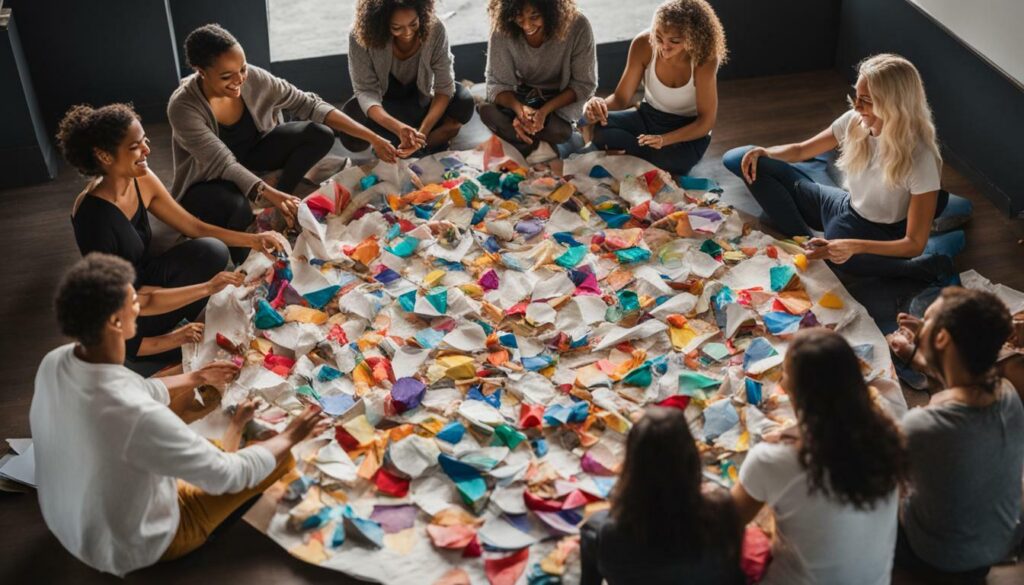
“Creativity is intelligence having fun.” – Albert Einstein
Embracing a Creative Life of Purpose and Meaning
Creativity is the driving force that propels us towards a life of purpose, meaning, and growth, inspiring us to learn, connect, and leave a lasting impact on the world. It is the spark that ignites our curiosity, allowing us to explore new possibilities and venture beyond the boundaries of what is known. By embracing creativity, we open ourselves up to a world of limitless potential, where our ideas have the power to shape the future.
In today’s fast-paced and ever-changing society, creativity plays a vital role in helping us navigate the challenges and uncertainties that come our way. It enables us to adapt, innovate, and find unique solutions to complex problems. As we cultivate our creative abilities, we develop a resilient mindset that allows us to face adversity with courage and determination. With creativity as our companion, we become better equipped to embrace change and find meaning and fulfillment in the midst of uncertainty.
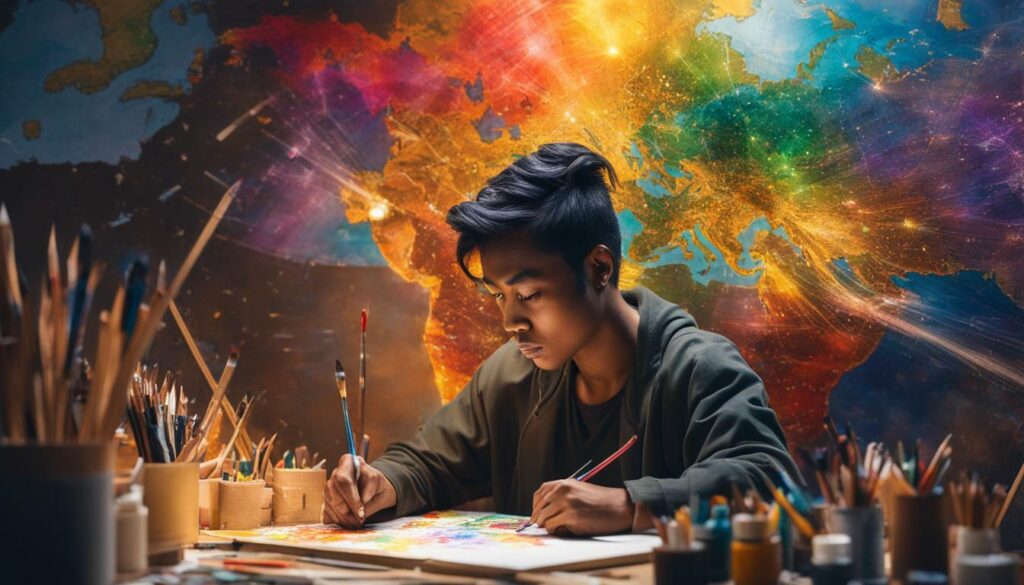
Nurturing Ideas and Building Connections
When we embrace creativity, we unlock a world of ideas and inspiration. It encourages us to think outside the box, enabling us to find innovative solutions and push the boundaries of what is possible. Creativity nurtures a sense of wonderment and curiosity, allowing us to explore and discover new passions and interests.
Furthermore, creativity builds relationships and connections, both with ourselves and with others. It encourages collaboration and teamwork, as we come together to bring our creative ideas to life. Through creative expression, we find common ground, building bridges that transcend cultural, social, and individual differences. In a world that often feels divided, creativity has the power to unite us, fostering a sense of togetherness and shared purpose.
As we embrace a creative life, we embark on a journey of self-discovery, personal growth, and fulfillment. It empowers us to find our unique voice, to express ourselves authentically, and to make a meaningful impact on the world. Creativity is not a passive endeavor; it is an active force that propels us forward, encourages us to take risks, and challenges us to step outside our comfort zones.
Summary: Why is Creativity Important
Embracing creativity brings purpose and meaning to our lives. It fuels personal growth, enhances communication, fosters resilience, and stimulates collective thinking. By nurturing our creative abilities, we cultivate a mindset of continuous learning, adaptability, and innovation. Creativity connects us to ourselves, to others, and to the world around us, enabling us to create a life that is rich in meaning, fulfillment, and impact.
| Benefits of Creativity: | |
|---|---|
| Personal growth and development | helps us learn and grow |
| Building connections and relationships | builds relationship and connections |
| Finding purpose and meaning in life | helps us find purpose and meaning in life |
Embracing the Creative Power Within
As you embark on your creative journey, remember that the power of creativity lies within you, ready to be unleashed and shape a future filled with endless possibilities. Creativity is not limited to a select few; it is a force that resides within each and every one of us. By tapping into your innate creative potential, you can ignite a spark that will fuel your personal growth, enhance your problem-solving skills, and open doors to new opportunities.
Creativity is more than just a talent; it is a mindset, a way of approaching and perceiving the world. It encourages you to think outside the box, explore alternative perspectives, and challenge the status quo. By nurturing your creative abilities, you can break free from conventional thinking and discover unique solutions to everyday challenges.
Embracing creativity also fosters a sense of togetherness and teamwork. It connects us with others who share our passions, allowing us to collaborate, learn, and grow together. Through collective thinking and collaboration, we can tackle complex problems, stimulate new ideas, and inspire positive change in our communities and the world at large.
Moreover, creativity nurtures confidence, instills curiosity, and keeps the mind active. It encourages us to communicate better, reducing stress and promoting relaxation. In a rapidly changing world, where uncertainty and adaptability are key, creativity provides us with the tools to navigate challenges and embrace new opportunities. By embracing our creative power within, we can cultivate resilience, find purpose and meaning, and build fulfilling relationships.
FAQ: Why is Creativity Important
What is creativity?
Creativity is the use of imagination or original ideas to create something. It’s characterized by the ability to perceive the world in new ways, to find hidden patterns, to make connections between seemingly unrelated phenomena, and to generate innovative and effective solutions.
Is creativity a natural talent or a learned skill?
Research suggests that both may be true. Some individuals are naturally more creative, yet creativity is a skill that can be nurtured and developed over time. Environments that encourage free thinking, exploration, and risk-taking may foster creativity.
How can I improve my creativity?
Creativity can be encouraged by engaging in activities that broaden your perspectives and break routine, such as learning a new skill, reading widely, brainstorming, practicing mindfulness, and actively seeking inspiration in different environments.
Is it possible to measure creativity?
Measuring creativity can be challenging because it’s a somewhat subjective and multidimensional concept. However, psychologists have developed several tests and measures such as the Torrance Tests of Creative Thinking (TTCT).
What is the importance of creativity?
Creativity encourages critical thinking, enables problem-solving, drives innovation in science and technology, and generally enhances the quality of life by bringing forth new ideas and concepts.
Can creativity be learned?
Yes, creativity is a skill that can be learned and cultivated. You can boost your creativity by incorporating creative exercises and routines into your daily schedule.
What factors impact creativity?
Creativity can be influenced by various factors such as natural talent, intelligence, thinking style, personality, motivation, environment, and culture.
What’s the relationship between creativity and intelligence?
Intelligence and creativity are two different traits. Some experts suggest that beyond a certain IQ threshold, there is little correlation between intelligence and creativity. It means you don’t have to be highly intelligent to be highly creative.
Can creativity be taught in schools?
Yes, schools can play a critical role in nurturing a student’s creativity by integrating creative approaches into their teaching methodologies and providing opportunities for open-ended problem-solving, collaborative work, and artistic expression.
How does creativity relate to innovation?
Creativity is the generation of new and original ideas, while innovation is the implementation of these creative ideas. As such, creativity is the first step in the innovation process. Innovation cannot happen without creativity.
Source Links
- https://www.youth.ie/articles/why-is-creativity-important-and-what-does-it-contribute/
- https://yonobi.com/blogs/news/being-creative-and-why-its-important-for-our-well-being
- https://www.creativityatwork.com/what-is-creativity/
Personal Development Unlimited is your go-to place to be You, Without Limits. We bring together personal development and self-improvement articles, books, courses and videos in one place. Find your self-growth opportunities easily.
Comments
0 comments


